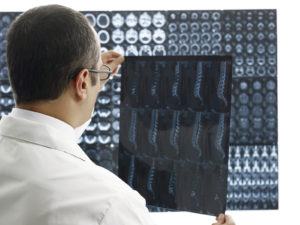
On Christmas Eve, Terry Compagner got an early present.
The back pain that plagued him for nearly two years had finally been relieved, thanks to a minimally invasive procedure performed by Sanjay Patra, MD, MS, a neurosurgeon at the Spectrum Health Medical Group Spine & Pain Management Center.
It was a long time coming.
There were moments over the past few years when Compagner, 58, worried that his back pain might keep him from fully enjoying the things he loved.
The father of four and grandfather of seven has, by all accounts, enjoyed an active life.
He worked more than four decades in the concrete industry, as owner of Compagner Concrete and Construction in Zeeland, Michigan. In addition to embracing the rigors of his career, he’s an avid golfer and enjoys snowmobiling.
So about two years ago, when he first began to experience back pain, he simply tried to muscle through it.
“I kept going, even with the back pain,” he said. “I just dealt with it.”
Eventually, the pain got so bad he couldn’t ignore it. It traveled out from his back, down into his legs, then into his knees.
Common culprits?
Age, weightAt least 80 percent of the population experiences some form of back pain at some point in their life, said Dr. Sanjay Patra. The majority of them will never need surgery.
Back pain, coincidentally, is one of the most common reasons people miss work.
When someone first gets back pain, the symptoms are usually mild. As the problem worsens, however, a patient can develop numbness and weakness and, in extreme cases, the patient can experience bowel and bladder problems.
Arthritis is a primary cause of back pain, and it usually worsens as a person ages. Not surprisingly, surgery is more common for people in their 40s and older.
Other conditions that can lead to back pain: obesity, depression and smoking.
In an obese patient, for example, an increased strain on the muscles can cause back pain. The heavier a person is, the more wear and tear on the spinal ligaments. This can also accelerate arthritis and contribute to more pinching of the nerves, Dr. Patra said.
“My hamstrings bothered me—they really got tight,” he said. “And, after a while, both my legs got numb. I was to the point where I had a hard time walking.”
That was about a year ago.
He finally went to his primary care physician at Spectrum Health, who referred him to Dr. Patra.
Early steps
Surgery, Dr. Patra said, is not the first answer to back pain.
“Generally, if a patient has back pain and shooting pain that goes down the leg, it’s usually from the nerves being pinched,” Dr. Patra said. “We try some physical therapy, or even steroid injections around the nerve. Some people can improve with just these treatments.”
Compagner saw some relief through cortisone shots, but it was fleeting. With each successive injection, the period of relief seemed to shrink.
At first, the shots kept the pain away for a few months. Later, they were effective for just a few weeks.
Soon enough, tests would show that Compagner’s condition merited more substantial treatment.
Many spine surgeries are necessary because nerves are being pinched, either by a herniated disc or by the overgrowth of the joint and spine due to arthritis.
While not everyone is a candidate for surgery, MRI scans indicated Compagner’s condition could indeed be alleviated by minimally invasive surgery, Dr. Patra said.
Spectrum Health has been on the cutting edge of this procedure, which over the past 15 years has been developed and refined, the doctor said.
Small spot, big benefits
A primary benefit of minimally invasive surgery: The small incision.
While the surgery generally involves use of medical instruments to repair the injury, it is most notable in that the doctor makes a much smaller incision to reach the injury, as compared to the larger incision made in traditional surgeries.
In more traditional surgeries, a doctor would perform a procedure through an incision of about 4 to 5 inches, Dr. Patra said. In that case, the post-surgery pain was often the result of the effects of that larger incision and the surrounding muscle being manipulated.
In the minimally invasive system, however, the doctor makes a 1-inch incision. In this smaller opening the doctor can accomplish the same decompression or removal of the herniated disc, with much less impact on the surrounding area.
Beyond reducing the post-surgery pain, the smaller incision—made with high-tech tools—can present other significant advantages.
Scientific studies have shown that a smaller incision causes less blood loss and reduces the spine’s exposure, which decreases the chance of postoperative infection, Dr. Patra said.
Also, given the improved technology, if there are signs of instability of the spine, the doctor can perform fusion procedures through the small incision.
Headed home
Minimally invasive surgeries can typically be done as an outpatient procedure, with the patient recuperating at home for a few days before slowly resuming activity. (A traditional surgery, of course, entails a hospital stay of at least two to three days.)
Compagner spent Christmas Eve in the hospital and returned home on Christmas Day.
While his overall recovery wouldn’t be overnight, it was certainly much quicker than if he’d had traditional surgery.
His surgery itself lasted about one and a half hours. He was up and walking briefly afterward, and by Christmas morning he went home walking well.
He has nothing but praise for Dr. Patra and Spectrum Health.
“I feel great compared to what I did (before the surgery),” he said. “I’m walking without pain. Dr. Patra is awesome. He explained how he would do the surgery and showed me the MRI. He was down to earth.”
Compagner had to take it easy for a few weeks, but he quickly resumed many of his normal activities—most importantly, without the back pain.
His recuperation fit nicely with his personal plans.
He headed to Florida for a few weeks, with plans to play his first post-surgery round of golf at the end of March. He’s once again working at Compagner Concrete, which is now owned by his son.
Free of back pain, Compagner couldn’t be more pleased with the surgery.
“I feel really good,” he said, “and really, really happy with the way things went.”
 /a>
/a>
 /a>
/a>
 /a>
/a>
This article is good, but not enough detail, for people who have had previous back surgery.
You did not give me any hope, I am 79 and have Neuropathy and now Arthritis of the Spine.
Now I wake up every night with pain. Yes, I fall back asleep but I use meditation to get me there.
Yes, I am starting to get foggy in my brain, but walking is out of the question, gardening is now watching my plants bloom, My life is to the point , I am waiting for relief.
Hi Eve, Sorry to hear of your troubles. Our stories serve as a jumping-off point. We sure do hope you’ll be able to discuss your difficulties with your physician or specialist to get the relief and hope you seek. Best wishes from the Health Beat team. 🙂